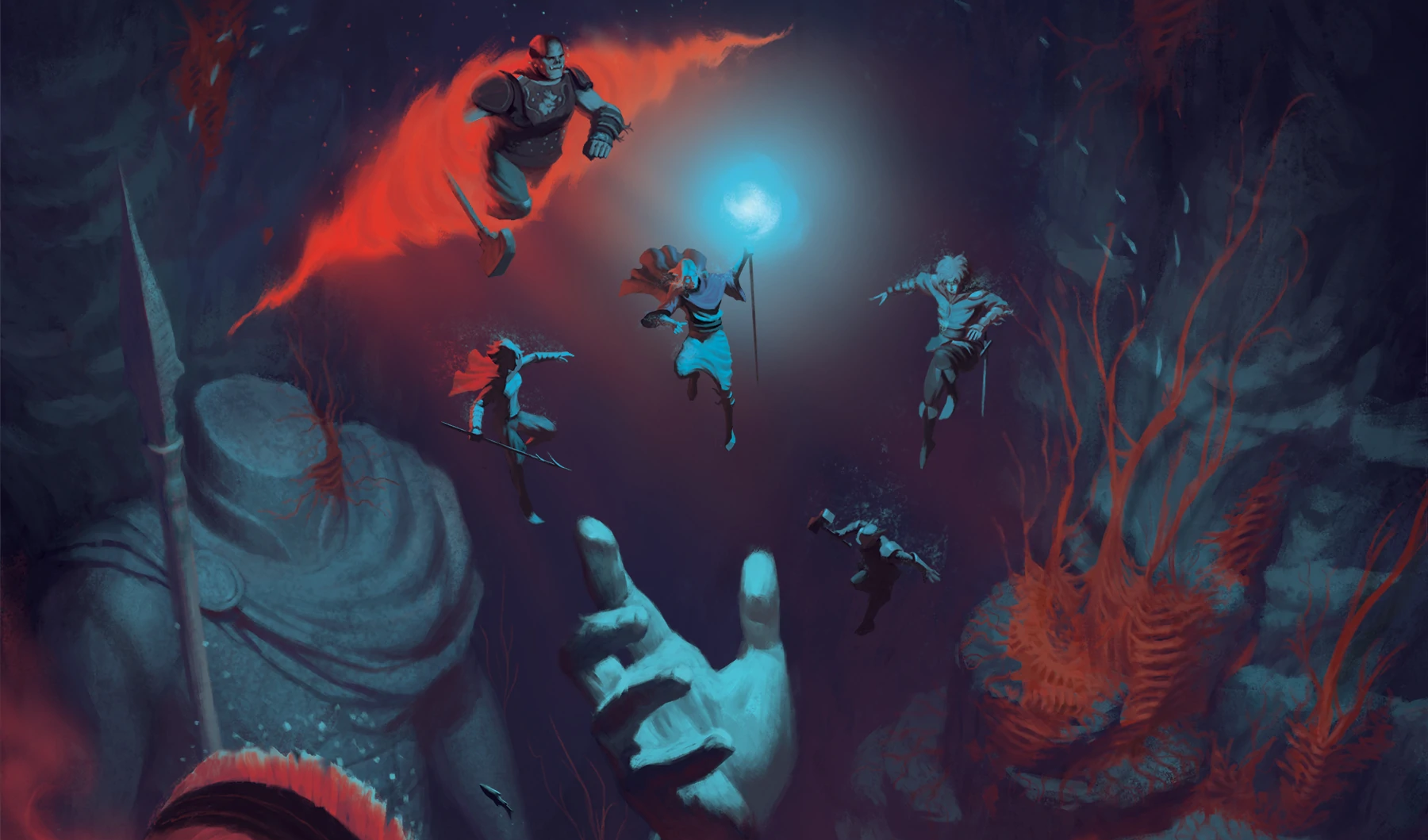The last piece of the puzzle here is that, in order for the Rivals and PCs to disagree about the current agenda, there has to BE a clear agenda for them to disagree about. As noted, this is something that Call of the Netherdeep struggles with.
Even if the Rivals weren’t a factor here, this is still something you’d want to fix. In fact, the Rivals can be a good diagnostic tool: If you hit a section of the campaign where you can’t figure out how the Rivals could have a competing agenda, that’s probably a good indication that you’ve failed to give the players enough information to have an opinion and a choice of their own.
Fortunately, I think addressing this problem doesn’t have to be particularly complicated. You just need to focus on two things. First, backfilling the lore surrounding Alyxian the Apotheon. Second, making sure there’s a clear goal (or choice of goals) at each stage of the campaign.
LORE OF ALYXIAN
When the PCs reach the Netherdeep, they are confronted by an extraplanar extrusion of a demigod’s traumatized mind. In exploring the physical space of the Netherdeep, they are simultaneously delving into the mystery of Alyxian’s past (and the trauma he has suffered).
This is a really cool dungeon, but in its current form the Netherdeep is doing most of the heavy lifting for both establishing a mystery (What is Alyxian’s story?) and then also solving that mystery. If you want to elevate this material, then you need to pull some of this amassed lore backwards so that it appears meaningfully earlier in the campaign. (All the way back, in fact. From the Emerald Grotto if not earlier.) What you want is for this enigma (Who is the Apotheon?) to be much more front-and-center throughout the campaign, so that by the time the PCs get to Netherdeep the players are fully engaged with the mystery and trying to figure it out. The Netherdeep should just be the focused resolution, as they fill in the gaps and realize some deep and terrible emotional truths.
The result will be much more satisfying, and feel more like the culmination of an entire campaign, instead of just another procedural step.
To understand what I mean here, let’s consider one small, concrete example: In Area 24 of the Netherdeep, the PCs encounter Perigee the Deva. This celestial actually fought with Alyxian during the Calamity centuries ago and remains, ruidium-corrupted, by his side even now.
This could be a really incredible moment: The PCs get to meet this legendary figure out of myth!
… but it really only works if you know who Perigee is before you walk into that room. And in Call of the Netherdeep, you don’t.
Imagine that you went on an adventure in the dungeon beneath the hill where King Arthur is buried, fated to rise in Britain’s hour of greatest need. As you journey through the dungeon you encounter some of his knights: Galahad, perhaps. Percival. Guinevere.
Those are cool moments because you recognize those names: “Holy crap! It’s Guinevere!”
But you don’t get that moment with Perigee because… well, who the heck is Perigee? No one at the table cares.
But if you establish Perigee earlier in the campaign — she appears in a mural in Betrayers’ Rise; she’s mentioned in a scrap of poetry; she has a statue in Cael Morrow or the Emerald Grotto — then you CAN have the moment of, “Holy crap! It’s Perigee!”
You just have to put the work in.
Check out Getting the Players to Care for various techniques you can use for doing this. There are already numerous opportunities throughout the campaign for including this lore, you just have to take advantage of them:
- Establishing the Calamity during the Festival of Merit.
- Murals in the Emerald Grotto prayer site.
- The first vision.
- What the Elders of Jigow know.
- What basic research in Jigow can uncover.
- Lore in Betrayers’ Rise.
- Lore held by the Bazzoxan researchers.
- What advanced research in the libraries and lore-stocks of Ank’Harel can uncover.
- More material seeded in Cael Morrow.
Use the Three Clue Rule and build your revelation lists. And this will require some care and thought: Don’t reveal enough? The players aren’t engaged with trying to figure it out. Reveal too much? You’ll undermine the revelations in the final act.
You’ll know you have the balance right if:
- The players already have strong opinions about Alyxian before ever reaching Ank’Harel (and, ideally, those opinions are varied and shifting); and
- The players have big questions about the Apotheon that they talk about and clearly want answers to.
This will allow the Rivals to challenge those opinions and to join in the discussion hypothesizing what the answers might be. But, even more importantly, the desire to answer those questions will motivate the agenda of the campaign.
CAMPAIGN AGENDAS
Call of the Netherdeep is a linear campaign (Jigow → Emerald Grotto → Bazzoxan → Ank’Harel → Cael Morrow → Netherdeep), which means that the structure of the campaign can be largely summarized as a series of agendas — i.e., the sequence of goals that move the PCs through the campaign.
In the adventure as written, these goals are generally underdeveloped, vague, and merely procedural. We’ve already seen, for example, how the PCs go to Bazzoxan because “an NPC told you to,” rather than having any true, actionable reason for going there.
As we discussed in the article on Running Betrayers’ Rise, we can strengthen the agenda which brings the PCs to Bazzoxan by seeding a specific piece of lore: The Jewel of Three Prayers is depicted somewhere in Betrayers’ Rise and the Jigow Elder knows this.
Tip: I also recommend that all of the characters in the Emerald Grotto — not just the group who claimed the Jewel — receive Alyxian’s vision. (And he remains connected to all of them.) Similarly, the Elder should seek out both groups the next morning. They share a destiny.
This sets up one of three key questions that should drive the campaign.
What is the Jewel of Three Prayers? Specifically, the PCs should be able to figure out that it was empowered by the gods to aid Alyxian three times; that shrines were erected in those places; and that they need to find the shrines in order to fully reactivate the Jewel.
What is ruidium and what should be done with it? It should become clear that ruidium is appearing at sites associated with the Apotheon.
Who is Alyxian the Apotheon? Piecing together the details of his story and framing the ultimate question of the campaign, which is whether he should helped, freed, or destroyed.
The PCs may not fully understand all of these questions to start with, but they should be pretty firmly in place by the time they’re wrapping up Betrayers’ Rise (even if the complete answers won’t be realized until Cael Marrow and the Netherdeep).
CORE STRUCTURE
Once the PCs get to Bazzoxan, the campaign moves into its core structure, which revolves around the scholar factions of Ank’Harel and their ruidium-based goals:
- Allegiance of Allsight (Prolix) want to use the ruidium to create weapons, armor, and other artifacts that they can sell to the highest bidder.
- Consortium of Vermilion Dreams (Aloysia) want to secure a monopoly on ruidium so that they can study its deeper mysteries and have sole access to its power.
- Library of the Cobalt Soul (Question) believe that ruidium is dangerous and it must be either destroyed or sealed away so that it cannot harm the world.
First, in Bazzoxan, the PCs make contact with one, two, or three researchers from Ank’Harel, who clearly communicate:
- The identities of their factions;
- The ruidium-based goals of their faction; and
- The existence of ruidium in both Betrayers’ Rise and Ank’Harel associated with the imagery of the Jewel of Three Prayers.
Second, these researchers refer the PCs to their factions (or come back with the PCs to Ank’Harel to make the proper introductions).
Third, the PCs join one (or more) of these factions and begin doing faction mission for them.
Structurally, this is quite straightforward. The key thing is that the factions and (most importantly) their conflicting agendas are made clear to the PCs immediately (instead of being largely obfuscated until later in the campaign).
Because the PCs now need to make some choices about what THEY think should be done with the ruidium, dynamic relationships with the researchers in Bazzoxan and the factions in Ank’Harel can emerge through actual play.
This also creates the opportunity to organically create a meaningful dispute between the PCs and the Rivals: Just give the Rivals a different opinion about what the significance of ruidium is and what should be done with it.
Design Note: I suspect it’s likely that at one point this WAS the intended structure for Call of the Netherdeep. At some point during development, however, the decision was made to (a) script a scene with Aloysia as a monologuing villain and (b) have all the researchers in Bazzoxan play coy with what they know in order to create Startling Revelations™ in Ank’Harel.
If so, these decisions really broke the back of the adventure as written: The PCs are forced to blindly “choose” a faction without understanding the significance of that choice, and Aloysia’s faction has been railroaded off the table as a viable ally (even though the rest of the adventure acts as if the PCs are just as likely to join it). Much like the Rivals, the factions get reduced to a simply “Me Help” / “Me Fight” dichotomy.













